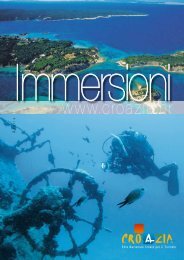Diving
Diving
Diving
You also want an ePaper? Increase the reach of your titles
YUMPU automatically turns print PDFs into web optimized ePapers that Google loves.
KVARNER<br />
The most attractive area as far as diving is concerned is around<br />
the northernmost islands of the Adriatic Sea, where divers can<br />
visit underwater reefs and walls, and the waters around Cres<br />
and Lošinj are shoulder to shoulder with the most attractive<br />
areas in the Adriatic – particularly their western shores – in<br />
clarity of the sea and the wealth of the submarine-living world.<br />
The area is full of underwater reefs with gorgonians and caves<br />
( at Premandura, off the east coast of Lošinj, Cres), and offers<br />
a wide variety of diving conditions for both beginners and<br />
advanced categories.<br />
The distribution of diving centres through this intricate area<br />
provide good coverage (Krk, Rab, Cres), while those based<br />
on mainland are mostly positioned along a belt from Rijeka<br />
to Selce. Because of the prevailing micro-location climate<br />
(occasional currents and northerly and easterly winds, better<br />
known as BORA), the area of the Velebit channel boasts<br />
particularly clear seas and excellent visibility. For divers, this<br />
translates into underwater localities with an abundance of flora<br />
and fauna, walls and reefs covered with rich colonies of soft<br />
corals and a variety of sponges, even in somewhat shallower<br />
Lina<br />
depths. Holding a prominent position here are veritable jewels<br />
of the Adriatic: the uninhabited islands of Prvić, Grgur and<br />
Goli, which oceanographers and biologists frequently describe<br />
as the Polynesia of the Adriatic because of the exceptional<br />
diversity of underwater life. The stretch of the mainland lying<br />
directly beneath the Velebit massif (particularly down from Novi<br />
Vinodolski) does not possess many diving centres, with most<br />
of nearest ones being on the island of Pag. The best known<br />
wrecks in this area are mostly German and Italian escort<br />
warships dating from WW2 (torpedo ships and corvettes) sunk<br />
by British torpedo boats, which are recommended for and<br />
visited by well prepared and experienced divers wishing to dive<br />
specifically at predefined sites.<br />
Cres<br />
These waters also conceal the remains of ships accessible to divers:<br />
Lina: Italian merchant ship sunk in 1912 during a severe blizzard close<br />
to the cape of Pečenj, on the island of Cres. Encountering difficulties in<br />
navigation due to fog and stormy conditions the ship ran aground and<br />
sank immediately by the shore, facing the land, its bow lying at a depth<br />
of 28 m, while its stern lies at a depth of 55 m. The hull, 70 m-long and<br />
with a beam of 9 m, is preserved, but the wooden decks have completely<br />
decayed which reveals the capacious cargo holds. Due to the depth<br />
at which the wreck lies the location is recommended for experienced<br />
divers, although the very good visibility makes it possible for beginners to<br />
view it from a safe distance.<br />
∆ Sepiola (4 cm) is a veritable predator that stalks the<br />
tiny crabs living in sponges<br />
Croatian National Tourist Board<br />
15




